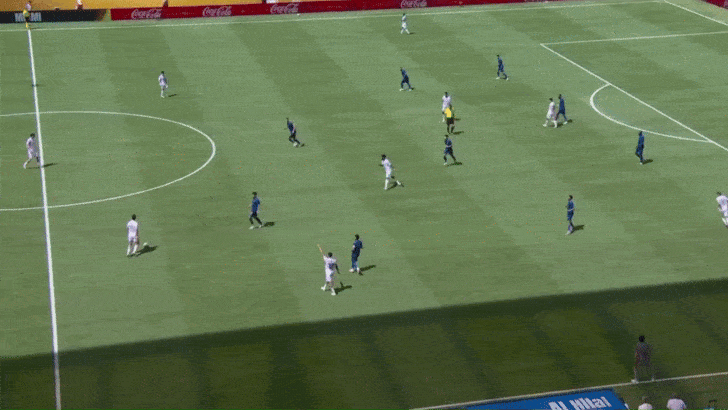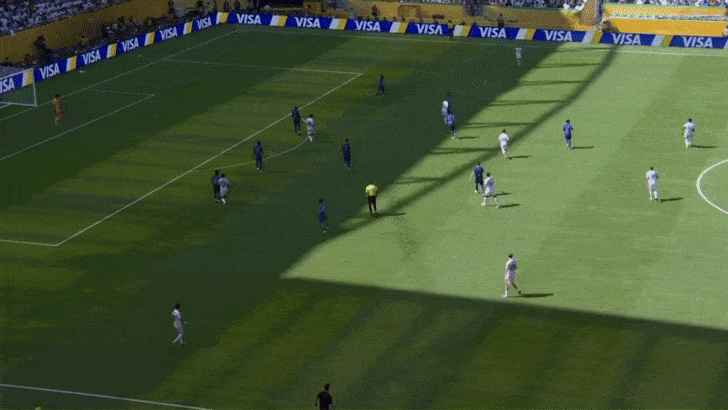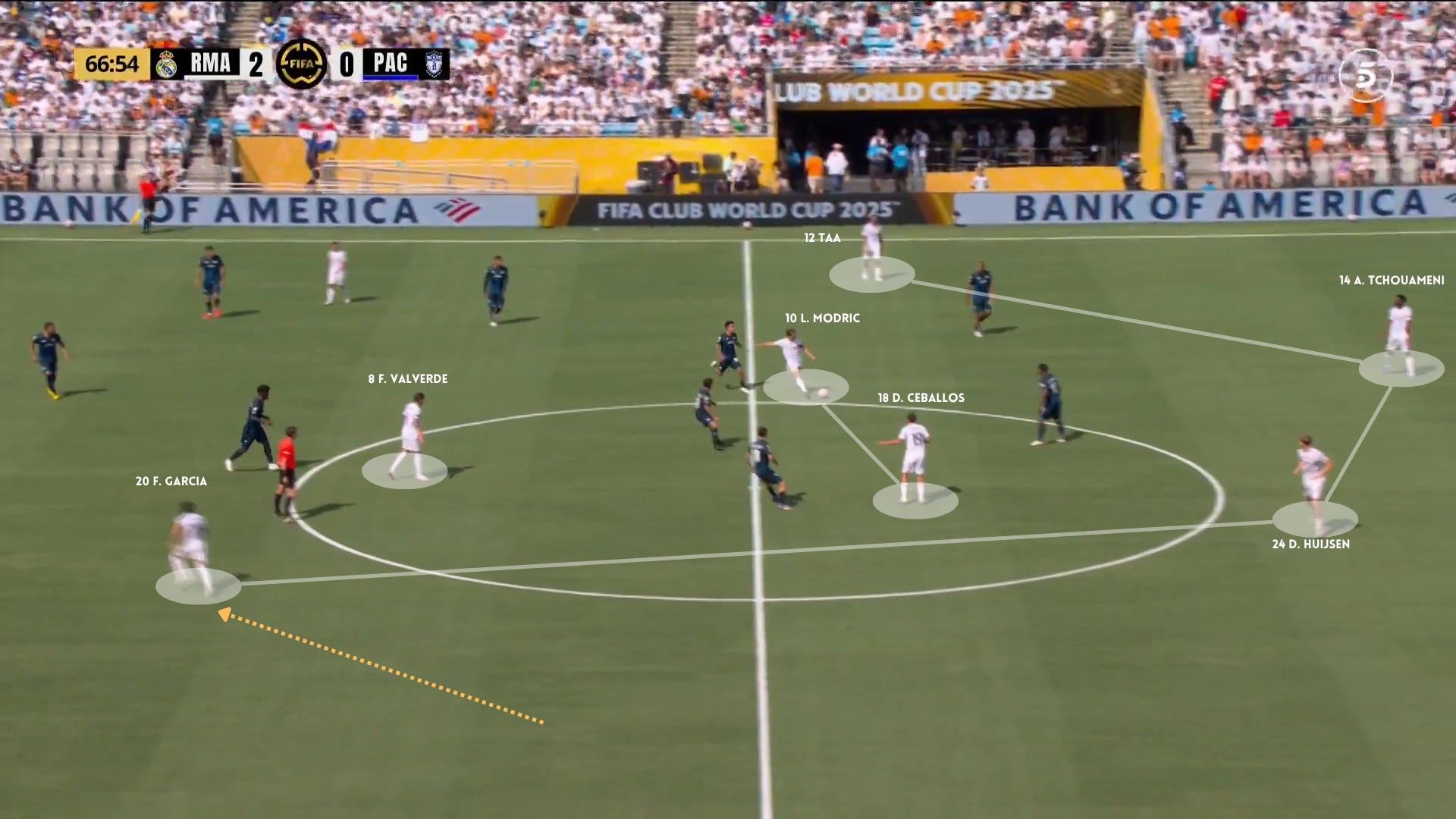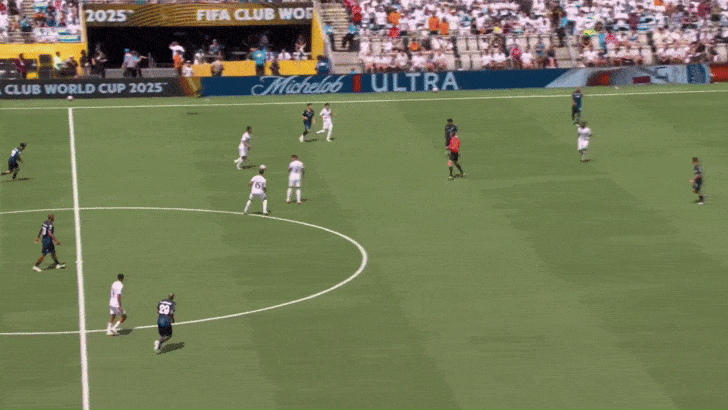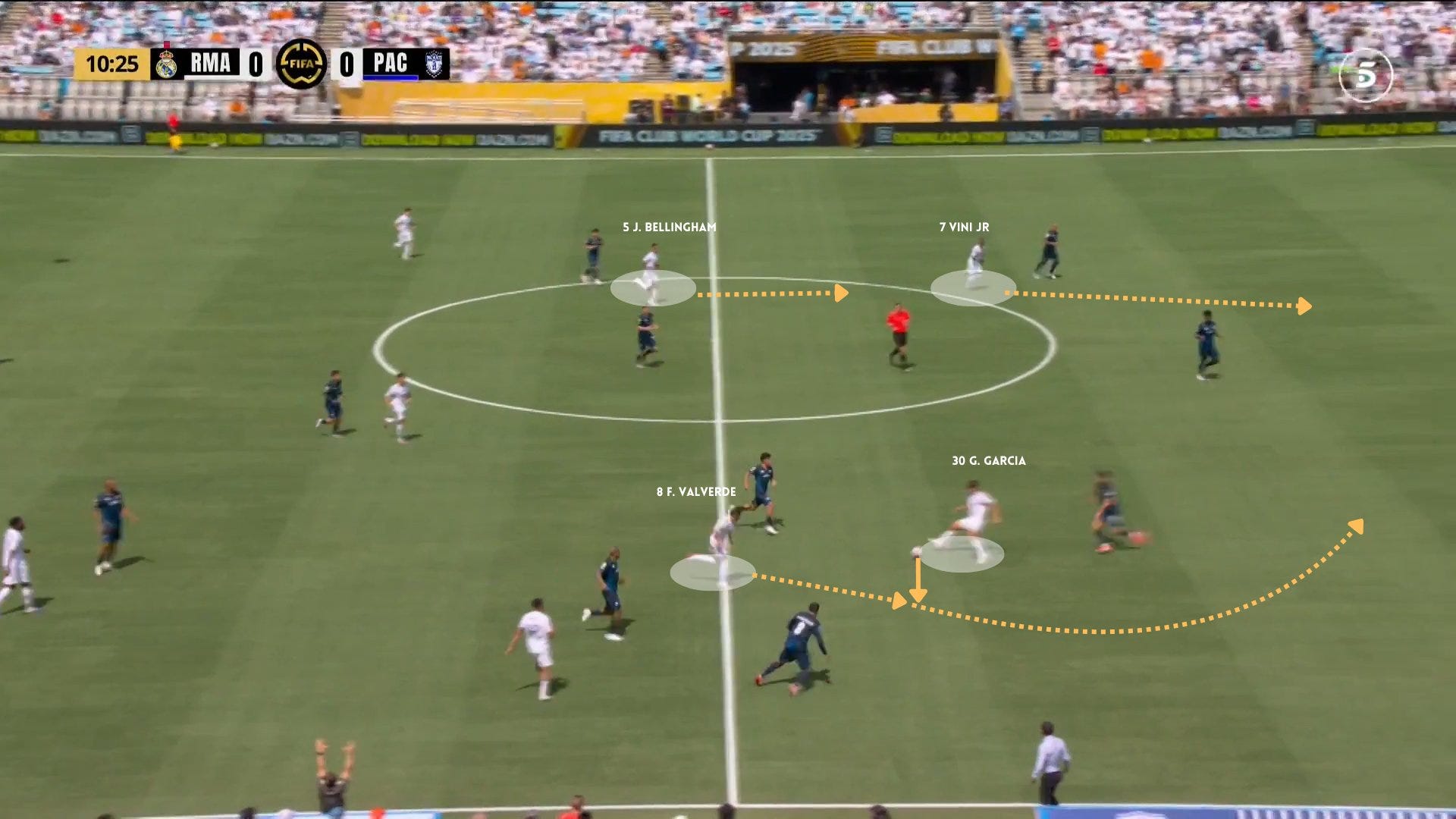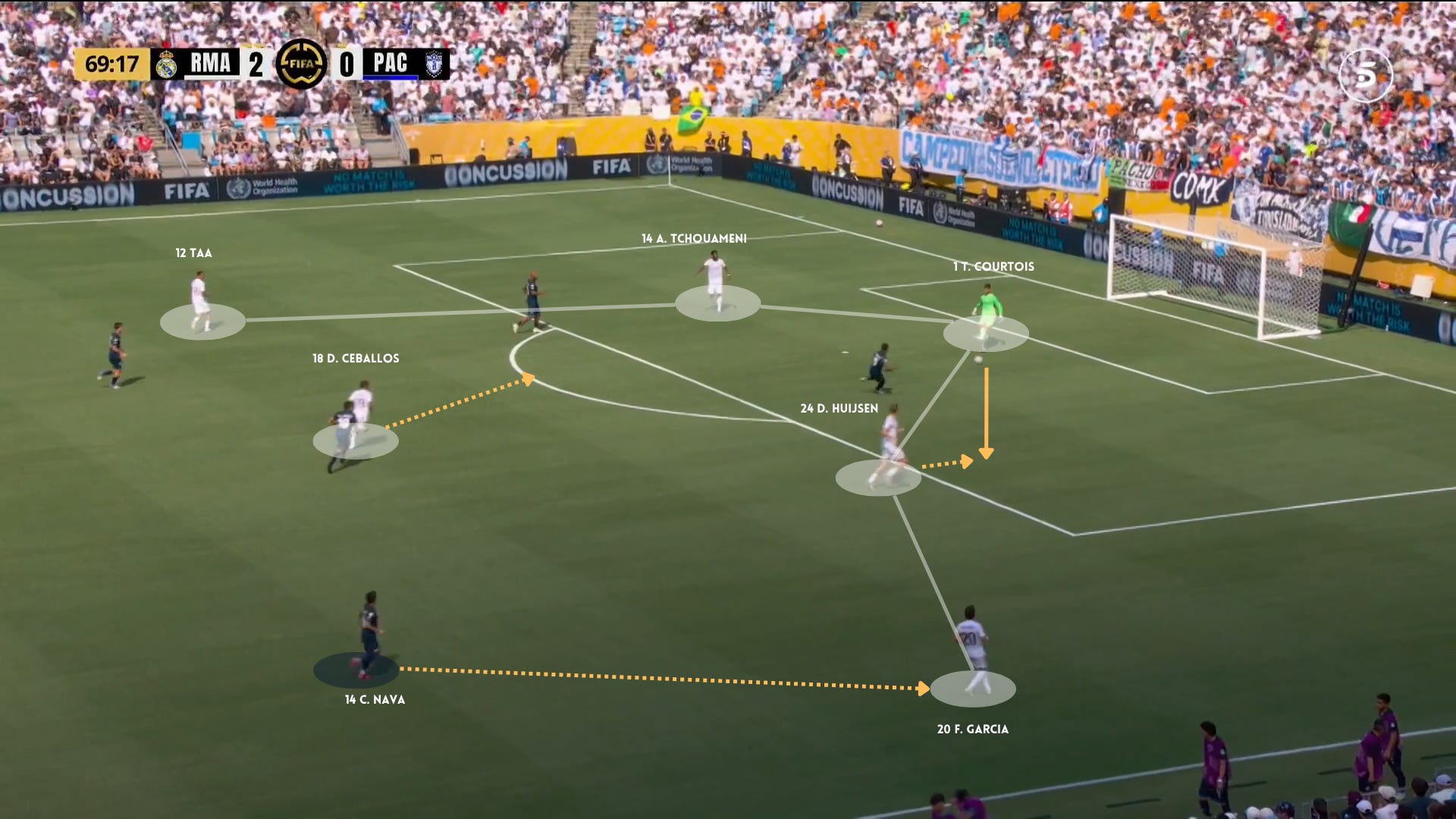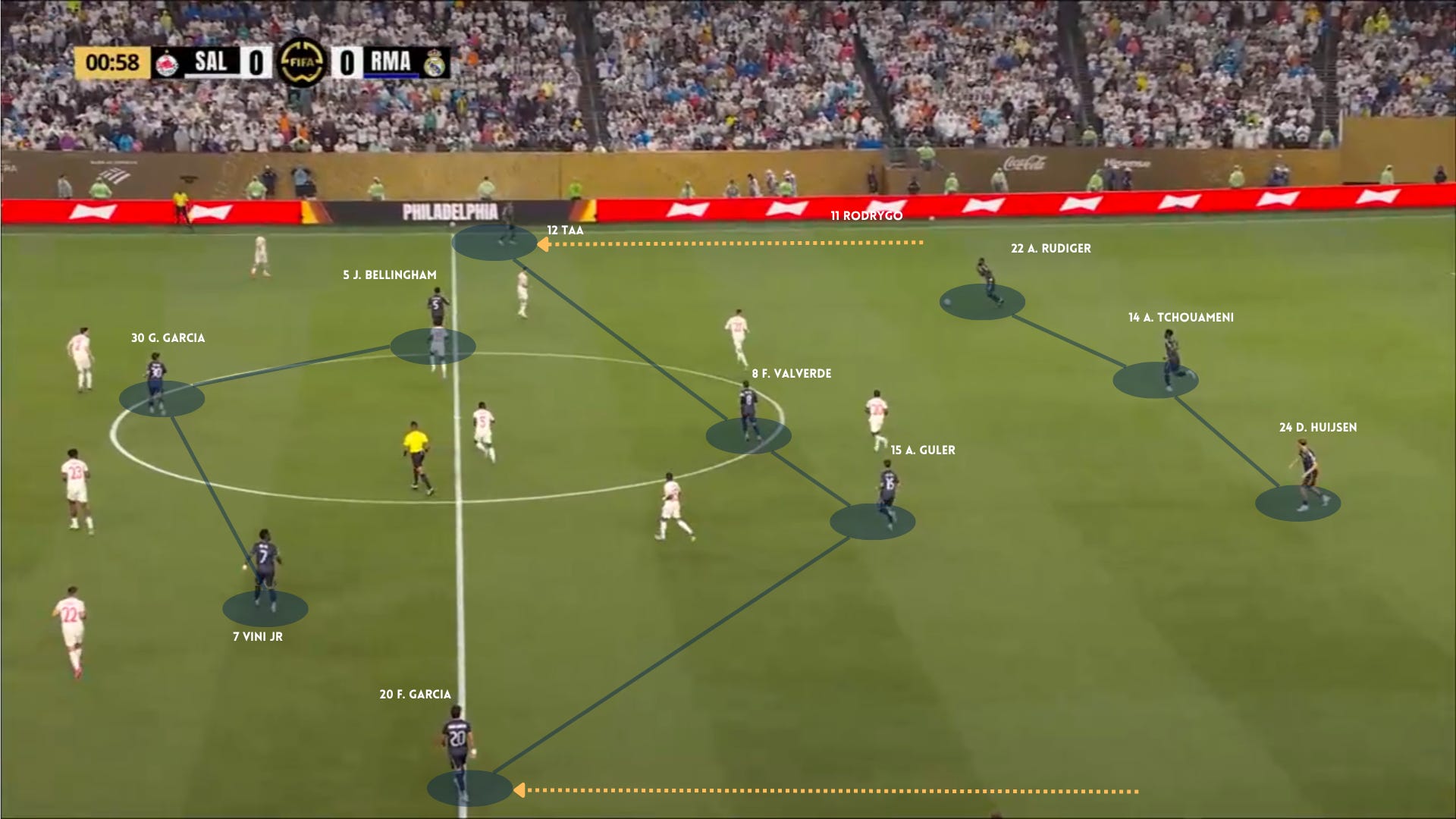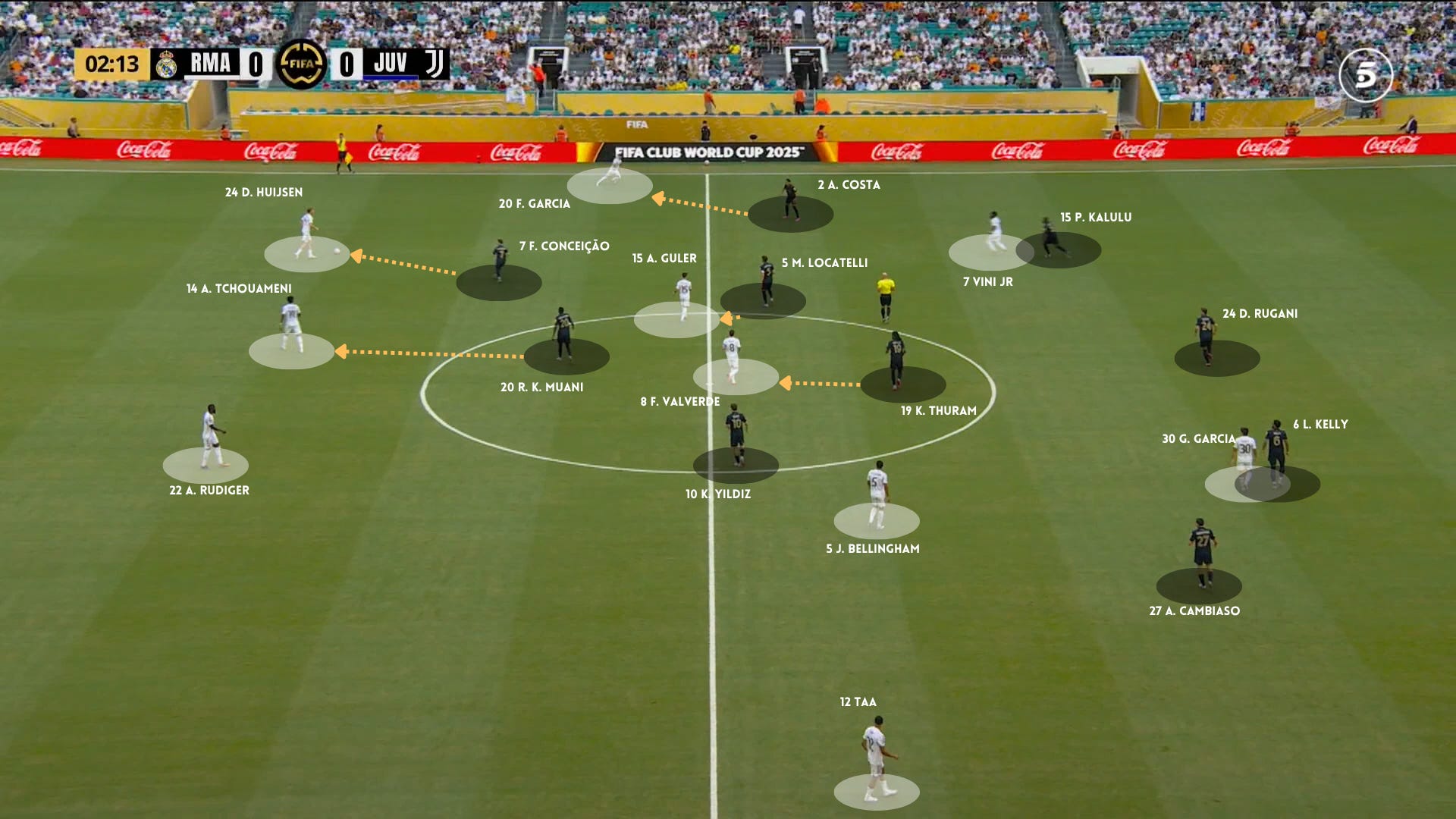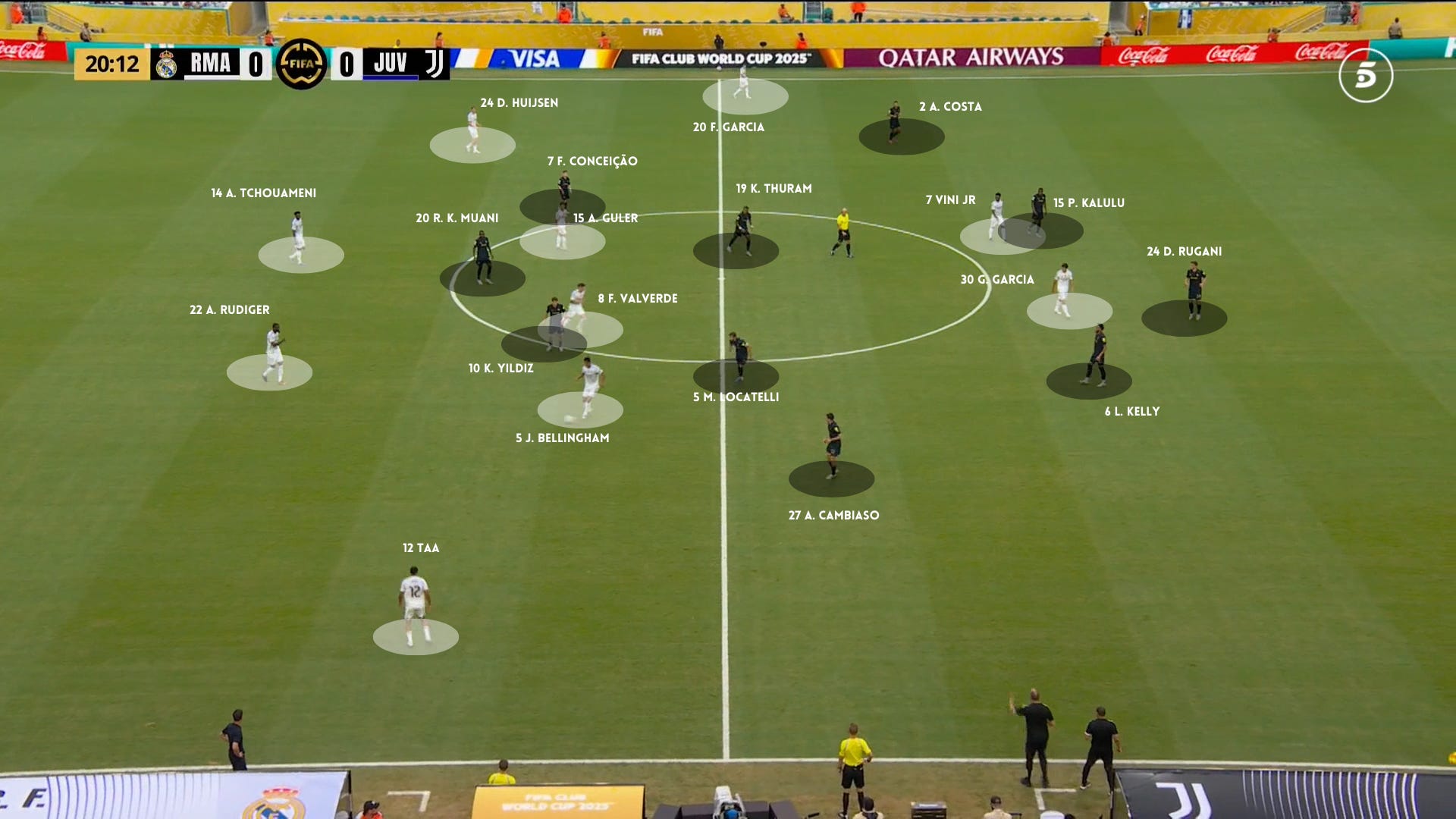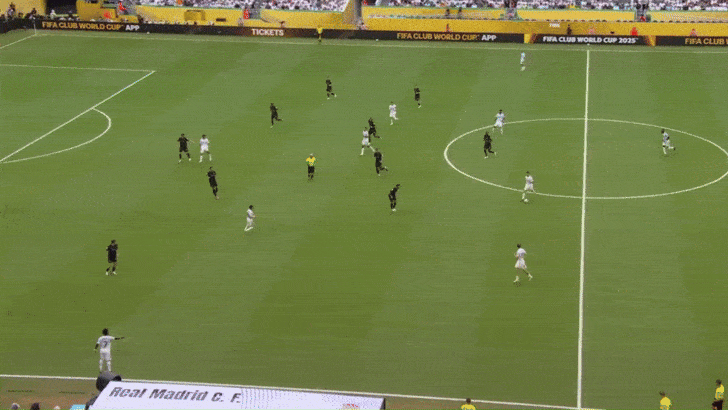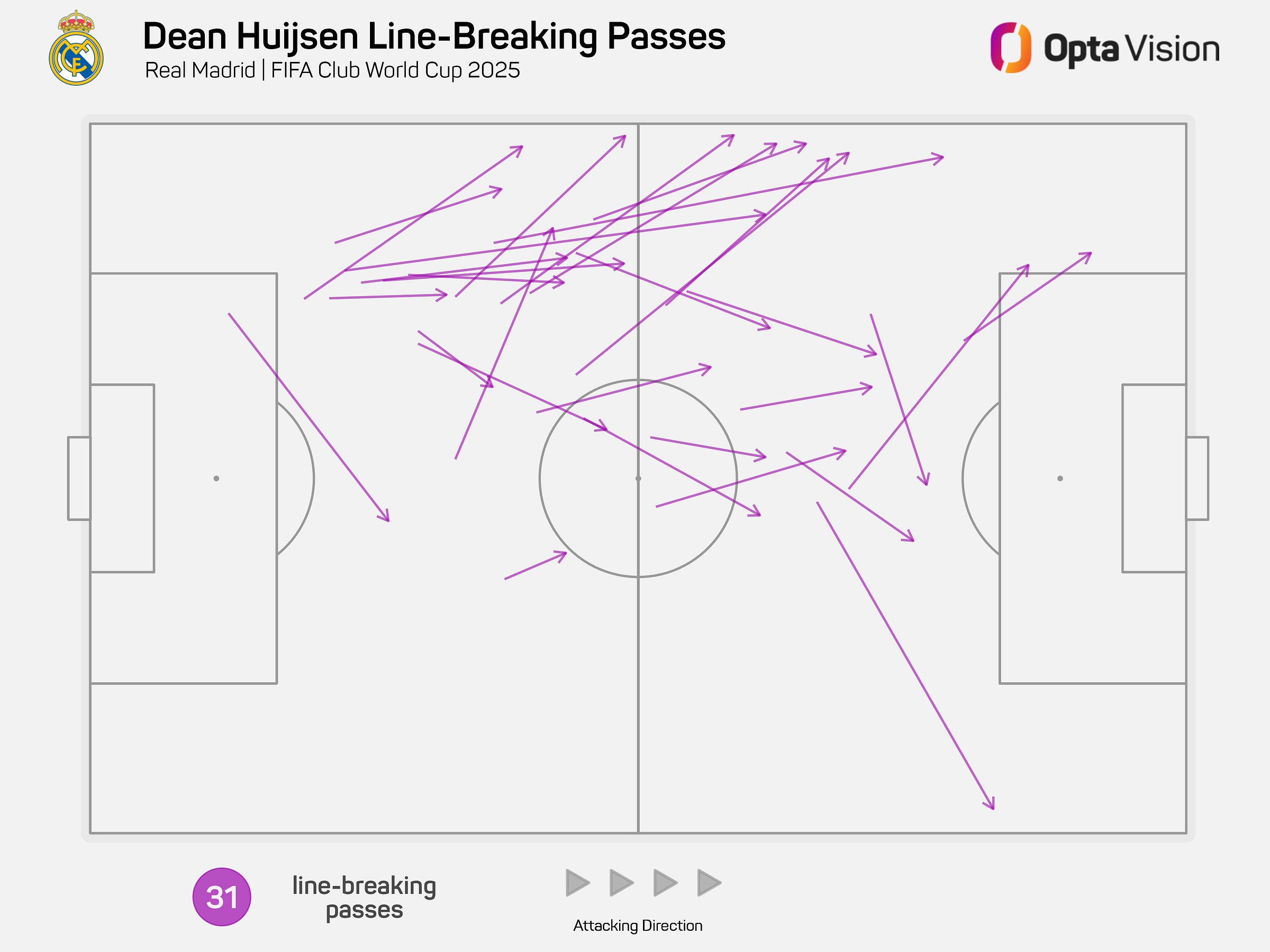Welcome Xabi Alonso
An analytical look at Real Madrid in possession with Xabi Alonso against Al Hilal, Pachuca, RB Salzburg, and Juventus.
“The only way to make sense out of change, is to plunge into it, move with, and join the dance” ~ Alan Watts
First, the football world is in deep sorrow for this loss.
Diogo Jota and his brother André Silva passed away.
I pay my tributes to their families and send my condolences to Diogo Jota's wife, kids, and the Liverpool Community.
Certainly, Diogo Jota will be missed but forever remembered.
The number 20 will be immortal at Anfield.
Also, all our thoughts are with all families who lost their loved ones under any circumstances. May their souls rest in peace.
I hope all these wars and atrocities stop. I hope we return to our essence and humanity, and peace will reign.
Carlo Ancelotti, becoming the Brazil national team coach, paved the road for Xabi Alonso to take over at Real Madrid. With all due respect, Bayer Leverkusen is not Real Madrid. In Madrid, failure is not an option; the ethos is all about winning. And Xabi Alonso is aware of the burden of the adventure he just dove into.
The first challenge is the Club World Cup.
The group stage and Juventus game embodied Xabi Alonso’s quote:
“It is more about what we think might happen in the game and where we should be to gain some advantage, but after, with the qualities of the player, we try to get some benefit”
The game against Al Hilal was an experimental laboratory where Xabi Alonso attempted to learn more about the players and their ability to improve and raise the ceiling of the group.
Against Pachuca, Xabi Alonso came to the conclusion that he was in deep need of a deep-lying midfielder who was going to dictate the play, facilitate the progression, and operate in tight spaces. In other words, Real Madrid looked desperate for a player who could fulfill the “Granit Xhaka” role. Arda Güler burst onto the scene.
Against RB Salzburg, Xabi Alonso returned to the 3-4-2-1 system. The team performed its best game under the Spanish coach. Central progression was the main theme. The attacks started at Tchouaméni's or Huijsen’s feet. The pair, with neat ball distribution, was able to pick out Arda Güler or Federico Valverde. One of them threaded between defense and attack. Bellingham strolled between the lines, dictating the attack, whereas Vinicius Junior and Gonzalo Garcia assumed the responsibility of finishing the team’s effort.
Against the Old Lady, Igor Tudor caught Xabi Alonso by surprise by sitting deep and countering when it was possible. Los Blancos looked off, offering nothing in terms of progression as they committed many players behind the ball. Alonso intervened, pushing Tchouaméni to play as a defensive midfielder and inserting more options between the lines. In the end, Alonso’s tweak reaped the reward.
🤔 Xabi Alonso's first game
In his opening game, Xabi Alonso defied all the speculations, stating that he would stick to the system in which Bayer Leverkusen played for the majority of the time under Alonso’s coaching. He claimed that in this era, tactical flexibility is a must to survive and thrive.
So, Real Madrid swung between 4-3-3 and 3-2-5 shapes.
Mainly, the structural change was led by Alexander-Arnold as he inverted as a situational pivot, allowing Valverde to push on in the right inside channel, or Fran Garcia advanced, enabling one of the central midfielders to form a situational back three.
In a 4-3-3 layout, Vinicius Junior and Rodrygo pinned Al Hilal fullbacks with Gonzalo Garcia drawing the attention of the center-backs. Moreover, Fran Garcia and Alexander-Arnold kept the opposite wingers’ hands tied. Hence, they created a 3v2 situation in midfield. Some of Real Madrid’s solutions to Al Hilal's press were the countermovements between the lone six and one of the central midfielders.
Real Madrid's structure in possession helped the back three, especially Dean Huijsen, from finding central pockets to progress. In this scene, Malcom drops back to his position after he has run onto Fran Garcia, Ruben Neves keeps tabs on Jude Bellingham, whereas Tchouaméni and Valverde dart horizontally in opposite senses, with Arnold inverting to outnumber Al Hilal in the middle of the park. That widens Al Hilal's second line laterally, which enables Dean Huijsen to glide the line-breaking pass into Gonzalo Garcia’s feet. However, Koulibaly aggressively steps out.
The English right-back narrowing inside was a double-edged sword, as it left Real Madrid vulnerable in counterattacks down the left side. In possession, Alexander-Arnold forced Al Hilal winger Salem Aldawsari to shift inside, which unsealed a direct passing lane between the backline and Rodrygo. Not only that, but Arnold’s inside channel run kept dragging Aldawsari with him, allowing Rodrygo to cut in and shoot.
It was interesting seeing Xabi Alonso's immediate tactical ideas, even if they were scarce in the first half. Central progression was one of them. Something the Spanish coach was renowned for in his days with Bayer Leverkusen. Real Madrid’s dynamics in midfield eased their walk through the Al Hilal block.
Here, Valverde takes a high position down the right inside channel to drag Al Dawsari (Al Hilal defensive midfielder) with him. Alexander-Arnold tucks inside to force the winger Aldawsari to follow him, with Ruben Neves man-marking Tchouaméni. On the left, Malcom is overburdened by Fran Garcia. As a consequence, Bellingham is freely roaming between the lines.
Furthermore, Tchouaméni, leaning slightly toward the right, unlocks the direct passing lane between Dean Huijsen and Jude Bellingham. From there, the latter just drives forward until Koulibaly steps out. Meanwhile, Gonzalo Garcia moves around the center-back Tambakti to receive Bellingham’s pass.
Xabi Alonso stated in his post-game interview that the performance was stale, the team was losing the ball quickly, so the balance was missing.
“The second half was considerably better than the first. We were lacking in several areas in the first period, both with and without the ball. We were losing the ball too quickly, we couldn't find a balance.” ~ Xabi Alonso
Nonetheless, Xabi Alonso claimed that the team started to find its feet in the second half.
“We managed to give a new look to the game, change the pace a bit and find more guys to bring the right rhythm and control to the play. That helped us get in good positions around the opposition box, adjust our press, and we spent more time near their area. This is a process. Everything takes time. The first half wasn't very good but we have to take the positives and look at how we can learn from the negatives.” ~ Xabi Alonso
🤔 What changed in the second half against Al Hilal
Physically, the Saudi Arabian team dropped. Xabi Alonso brought in Arda Güler, who allowed Real Madrid to stand on the ball—pausa—dictating the play from deeper positions. In addition, Vinicius Junior was tasked with holding the width, with other teammates providing him with the optimal situations to be in one-on-one positions.
As a result, Real Madrid built momentum as time elapsed on Al Hilal's pitch.
In the first minute of the second half, Xabi Alonso’s tactical adjustments brought the team close to finding the back of the net.
A 3-2-5 shape in which Fran Garcia inverted in the left inside channel, pinning Cancelo inside and forcing Malcom to track back. Vinicius Junior was deployed in a 1v1 situation where he could show his lethality. Not only that, but all five corridors were filled with the layout in possession, very narrow vertically to serve the counterpress missions.
Also, when Vinicius Junior drove toward the byline, the team attacked the box in numbers and with an optimal distribution to meet the Brazilian cross.
Gonzalo Garcia headed toward the center, facing the middle of the net to push Al Hilal's defense backward. Bellingham ran toward the near post with Rodrygo targeting the far post zone. Gonzalo Garcia's movement served players coming from behind well—Arda Güler—to attack the space between the edge of the six-yard and the penalty box. The result was immediate: Arda Güler hit the woodwork.
As aforesaid, Real Madrid’s narrow shape enabled them to regain the ball quickly. Therefore, the following phase resulted in Vinicius Junior playing the ball across to Gonzalo Garcia, who headed it into Bouno’s hands.
The use of width and depth positively impacted the flow of ball circulation. Moreover, making the best technical players (Bellingham, Güler, and Valverde) step back behind Al Hilal unit was a ceiling-raising in terms of infiltrating through the lines.
In this situation, Valverde forms a situational back three, which leaves room for Fran Garcia to advance and attract Malcom’s attention. Vinicius gets some chalk on his boots on the right, luring Cancelo to shift across. That saw Al Hilal's inside channel expand, and with Milinković-Savić jumping onto Valverde, Bellingham remains free to receive.
Fran Garcia's off-ball runs down the channel were key aspects in opening up spaces inside or creating isolated positions for Vinicius Junior near the flanks. In this sequence, his dummy sprint makes Ruben Neves believe that Bellingham will pick Fran Garcia out. So, the Portuguese midfielder adjusts his body accordingly. As a reaction, the Englishman accesses the available space on his right and notices Gonzalo Garcia sneaking behind Koulibaly.
These wide patterns kept occurring on the right side, and in abundance after Xabi Alonso took off Alexander-Arnold and Rodrygo, making way for Lucas Vázquez and Brahim Diaz. Arda Güler completed the triangle to kick off the wide combination. So, every move drags Al Hilal player, and thus a free space emerges for one of the trio to dash into. In other words, each movement instigates a chain of actions.
Check this. Lucas Vázquez runs down the inside corridor, forcing the winger Aldawsari to track him back. Brahim Diaz notices the free space inside and feeds Arda Güler. In the meantime, Vázquez shifts wide, vacating his zone for the Moroccan to attack. Renan Lodi goes toward Güler instead of following Brahim Diaz.
Ergo, the Turk has space to shoot or to slide a pass behind to Diaz. However, he chooses the first option.
Once again, Lucas Vázquez overlaps Brahim Diaz. Both being wide drags, Al Hilal's left-back and winger across, which consequently widens the inside channel for the Moroccan to attack. Arda Guler, in the right inside channel, obligates the pivot to stand still because the Turk can shoot or combine there.
A quick ball combination sets the latter in the box, and with Gonzalo Garcia and Bellingham’s runs to push the opposite defense deeper, Valverde is free at the edge of the box.
🚨 Playing with ten men
This was Xabi Alonso's words about how everything in football is interconnected. It is not rocket science. A well-synchronized high-press requires coordination and intensity from all team members. A high press must start aggressively and be well-structured to enable the backline the chance to back it up, maintaining the same quality.
"From the tactic board to the pitch, from training to matchday, nothing is ever perfect. Football is not about absolutes. Many times, we need to go through success or failure before we truly understand what works and why. You might look at the high line and think it's the problem, but often, it's about what happens in front of it. If the press is more coordinated, more aggressive in the higher zones, then the same high line becomes a strength, not a weakness. It’s all connected. You can't isolate one part, it's always about the whole structure working together." ~ Xabi Alonso
From a static position, Real Madrid does well, initiating the press with a curved run from Vinicius Junior to direct the play sideways. Everything looks good at first glance until the ball starts circulating between feet.
In this situation, Bellingham misunderstands the process. As a result, the Highline becomes a liability. He and Fran Garcia run onto the same player, whereas the Englishman is supposed to allow Fran Garcia to jump onto the opposite right-back and stand still with Pachuca pivot, Palavecino.
Bellingham’s movement opens the diagonal passing lane between the right-back and ball-side pivot. Tchouaméni cannot react in time because he’s marking the attacking midfielder, Bautista, and the distance between him and the ball plays in Palavecino’s favor. As a consequence, the latter prods the ball onto the striker. Only Raúl Asencio’s recovery run can wipe out the danger.
One of Real Madrid’s problems throughout Carlo Ancelotti’s tenure was the players' lack of awareness and literacy in using body positioning to cut off passing lanes.
This is an excerpt from Real Madrid: Why The White House Needs To Be Revamped:
“During Carlo Ancelotti’s second tenure, playing against Real Madrid’s high press is a walk in the park. Passing lanes are available for the opposition to connect passes. Wrong body positions and angles streamline opponents' buildup and progression. As aforementioned in the previous example, Real Madrid's pressing structure from a static position—when the opposition plays a goal kick—is generally acceptable. However, as the sequence starts, everything that follows renders Real Madrid vulnerable.
From an open-play situation, Carlo Ancelotti’s men display nothing more than chaotic, lethargic, and primitive press. Nothing reflects the quality at the Italian coach’s disposal.” ~ The Inside Channel
Raúl Asencio’s red card was just a consequence of what occurred on the front lines. Of course, he has to take his part of the blame. However, as Xabi Alonso said, it is about the whole structure functioning as a unit.
Here, Vinicius Junior takes a position a little bit inside, hence the center-back, Eduardo, effortlessly accessed the right-back. The play went sideways, which was an advantage for the white team.
But, lack of intensity was the problem again. Vinicius Junior shifted wide for the sake of the duty without urgency or body adjustment to force the ball out or the play backward. Consequently, the ball holder had half of the pitch at his disposal to dink the ball over the top.
Coming to the backline, you may blame Dean Huijsen for playing the Pachuca striker onside. However, zooming in on Real Madrid’s defenders body language and actions reveals that the offside trap was not Plan A.
Moreover, it becomes clear that Alexander-Arnold and Raúl Asencio were not in sync with Dean Huijsen, whose attention was on the ball and chose to retreat. By being further in, Raúl Asencio allowed Rondon space to be ahead of him.
🛠️ Buildup structure
After Raúl Asencio was sent off, Tchouaméni dropped to play as right center-back. In the deep buildup, Real Madrid constructed with a back four and double pivots ahead, with Valverde joining the crew. The midfield line was dynamic, but the structure remained the same.
Playing with one player off has always been a disadvantage. Therefore, Xabi Alonso relied on his most technical players to assume the responsibility for the buildup and progression. Connecting passes via one or two touches, and moving the ball to move the opposition was what made the difference. The telos was to generate space from where Real Madrid wanted to progress.
The operation started with Dean Huijsen sliding a neat pass between Pachuca's front two to access Tchouaméni. Then, circulating the ball toward the touchlines to shift Pachuca’s lines across was the goal. As a result, the space appeared where there was no space when the sequence took place. Consequently, the team created a 3v2 situation in which Dean Huijsen took advantage and scampered forward.
The 4+2+1 buildup structure was enough for Real Madrid to bypass Pachuca's high-press. In fact, the Mexican team wasn’t pressing with the required intensity to hinder Real Madrid in the first phase. Not only that, but they allowed Alonso’s players space with the backline acting passively. That resulted in the white team generating a 3v2 situation in midfield.
Dean Huijsen continued to act as if he had been playing with Real Madrid for a while. The Spanish center-back was a total upgrade, improving his team’s buildup, a phase that was a pain in the head after Toni Kroos’ retirement. Check this. He spotted Pachuca’s inert high press and pointed to Valverde to move across toward the right behind Bautista. Huijsen’s pass unbolted the left inside channel for vertical progression from which Bellingham was close to setting free Gonzalo Garcia behind the defense, should not Eduardo intercept the pass.
The 4+2 shape is not static. Fran Garcia reacts according to Vinicius Junior's position. The pair gradually compose a harmonious partnership. If the Brazilian hugs the touchlines, Fran Garcia underlaps. If Vinicius Junior tucks inside, the Spaniard overlaps. The first case is usually a sign for Vinicius Junior to pass the ball behind, whereas the second occurs to soak up pressure and allow the Brazilian to cut inside (still valid for the first option).
Fluidity within a structure is Real Madrid’s new theme. Personnel could interchange positions, as it smoothens the progression, and sets a perplexed state within the opposition to process and rearrange their lines. Hence, time and space are on Real Madrid’s side.
Here, Dean Huijsen operates as a situational left-back. That saw Dani Ceballos drop in Huijsen’s spot, while Fran Garcia inverted. Huijsen invites pressure, and Ceballos forges his way through. Meanwhile, Fran Garcia sprints forward, vacating the center for Vinicius Junior to drop and receive. As a result, Real Madrid breaks down Pachuca’s attacking and midfield lines.
➡️ Vinicius Junior in central channels
After the red card, Xabi Alonso brought Tchouaméni back to defense. Thus, Bellingham and Valverde had to drop off and operate deeper. That evacuated the central corridors, with only Gonzalo Garcia as an option in the center. Xabi Alonso tasked Vinicius Junior to narrow inside.
It served the team well and facilitated the inside channel combinations as the Brazilian represented a thread between the left and right sides.
In the second goal against Pachuca, Vinicius Junior comes short between the lines, notices the opposite left back is dragged inside, and switches play toward Arnold into free space. Bryan González—Pachuca left back— jumps onto Arnold, which widens the distance between him and the center-back for Arda Güler to come from behind and net Gonzalo Garcia’s layoff home.
Narrowing inside allows Vinicius Junior to swap positions with Gonzalo Garcia. So, the team could take advantage of his runs behind the defense or stretch the opposition’s lines vertically.
Real Madrid’s opener against Pachuca is the embodiment of that. Gonzalo Garcia fills the left inside channel and darts deep to receive Valverde’s pass. The striker pulls Pachuca’s right-back out of his position, enabling Fran Garcia to exploit the space behind. Gonzalo Garcia flicks the ball toward the flying left-back. In the meantime, Vinicius Junior races out, pushing Pachuca’s line backward and allowing Bellingham to come from behind, collect the lateral pass, and penetrate the box to give his team the lead.
Kylian Mbappé’s disease had been nothing more than a blessing in disguise. Gonzalo Garcia, a Real Madrid academy graduate, burst onto the scene. He has all the requirements under his belt to play as a striker. He is intelligent in moving without the ball to free space by dropping deep or dummying his actions to deceive his opponent. He already displayed good signs of a striker who could link up the play, building a great understanding and connection with his teammates.
Check this. By dashing deep, Gonzalo Garcia hits two birds with one stone. He unlocks the diagonal passing lane between him and Alexander-Arnold. Also, he draws Pachuca’s center-back upward to generate space behind.
Not only that, but he neatly lays the ball off to Valverde, who runs into a free island. Meanwhile, Vinicius Junior moves his body behind the defense and drags the right-back with him.
Hence, Valverde could choose between setting the Brazilian free or targeting Bellingham, who comes late from behind on the far side. The Uruguayan opts for the first option. However, Pachuca's center-back cuts off Valverde’s pass.
The third goal was a mesmerizing sequence between both ends of the pitch. The structure remained intact. A 4+2 shape in which Courtois added himself to the mix to generate an overload.
With Ceballos coming short, he evacuated the left inside channel for Dean Huijsen to carry the ball into space. Pachuca’s right-back couldn’t commit as he took charge of Fran Garcia. Luka Modrić asked for the ball; however, Huijsen had already caught Vinicius Junior running down the channel. Therefore, he poked the ball behind Pachuca’s defense.
Vinicius Junior found Valverde between the lines. The latter, with a “give and go” play, attacked the space between the center-backs as Eduardo recovered late after following Vinicius Junior. All that Brahim Diaz had to do was to dink the ball to Valverde and let him complete the job.
➡️ Salzburg, Real Madrid a la Bayer Leverkusen
This was Xabi Alonso's post-match statement about him opting for a 3-4-3 formation.
“I've always been flexible with systems. The players are already smart enough to know the positives and negatives of this system. It's given us stability, maturity, and control of the game. It gives you three-on-two outlets with Huijsen and Rüdiger out wide and spaces in between with Jude and Arda. I like that flexibility so I can use it when necessary.” ~ Xabi Alonso
In the 3-4-3 setup, Alexander-Arnold provided the width. As a reaction, Salzburg's left-back jumped on. Gonzalo Garcia secured the depth by pinning the center-back. Thus, the inside channel was expanded for Bellingham or Valverde to run from the blindside and attack the free space.
Xabi Alonso claimed that the 3-4-3 system gave the team control and stability. He referenced both in and out of possession. In addition, playing with a back three gave the team with the ball the edge in terms of numbers in the first line. Off-ball, it allowed Real Madrid optimal coverage and security horizontally and vertically.
Not only that, but the team maintained close distances while circulating the ball, which eased Los Blancos to pounce immediately after a possession loss in Salzburg’s defensive third. Therefore, the Austrian team looked unable to transition and break through as Alonso’s boys kept swarming and hunting in packs to force the play backward.
To counter Real Madrid's back three, Salzburg's attacking midfielders tended to spring toward the wide center-backs. However, that only pulled apart their lines and opened up a direct passing lane between the backline and players between Salzburg midfield and defense.
In this scene, Vinicius Junior and Fran Garcia swap positions. The former hugs the touchlines, whereas the latter roams inside. As Fran Garcia receives in space for the reasons mentioned before, the center-back, Gadou, steps out. Then, a domino effect takes place. Vinicius Junior attracts the opposite right-back, Gonzalo Garcia dashes across, dragging the center-back, Rasmussen, with him. That resulted in the appearance of space at a premium for Bellingham to run into.
The 3-4-2-1 formation provided Real Madrid with the optimal horizontal and vertical distribution and thus the best scenario to find each other and work the ball out centrally. Playing with a back three afforded Los Blancos +1. As a reaction, Salzburg had to commit one of the attacking midfielders.
That tipped the scales toward Alonso’s team, as the attacking midfielder’s jump meant that the center was vacated. Between the lines, Bellingham was free thanks to Vinicius Junior and Gonzalo Garcia pinning the center-backs. Hence, it sufficed to time and deliver neat passes from the back to arrive in the box.
Real Madrid's inside channel interplay was smoothed by shifting into a situational back four. When Dean Huijsen pulled wide, it allowed Arda Güler to dictate the play from deep. Therefore, it was a twofold gain for Los Blancos as Salzburg's lines were stretched horizontally, and Madrid’s most technical player operated behind traffic so he could break down the Austrian team's block with his neat, well-timed passes.
With the positional rotations, Real Madrid always secured the depth by making one of the front three ties the hands of the opposite center-backs. Here, Rasmussen is doubled up by Vinicius Junior and Bellingham. Gonzalo Garcia comes deeper to lay the ball off to the Brazilian. The former pulled Gadou out of his position, whereas the latter drew Rasmussen across. As a result, the gap between the center-back and left-back widens for Bellingham to attack.
👉 Xabi Alonso’s tactical tweaks
In the second half, Xabi Alonso adjusted Real Madrid’s buildup, instructing Tchouaméni to act as a pivot. So, the team operated in the initial phase in a 4-2-2-2 formation. With Courtois’ position between Antonio Rüdiger and Dean Huijsen, Real Madrid maintained the advantage of +1 in the first line. Salzburg’s attacking midfielders stayed between the wingbacks and one of Real Madrid’s midfielders (Here, Gloukh between Arnold and Tchouaméni, Dorgeles between Valverde and Garcia).
In addition, the defensive midfielder, Diambou, opted for keeping a zonal stance and an optimal distance with Bellingham. That was enough for the latter to drop, maintain separation, receive Courtois’ through ball, and find Valverde.
The Uruguayan’s engine reloaded to scamper forward and was ready to put Vinicius Junior in a one-versus-one situation had Lainer not touched the ball with his hand.
Having a press-resistant, brave center-back might be the dream of every coach around the globe. For the simple reason, they could bring their buildup ideas into reality. Dean Huijsen is one of them. Third-man combinations or one-twos are the common ways to bypass a high press. Dean Huijsen, here, just pokes the ball between Salzburg's front two, breaking down their first line.
Then, he invites pressure by standing on the ball and waiting for Bellingham to dart behind the pivot. In the meantime, Gonzalo Garcia pulls out the center-back, Rasmussen, with Gadou stepping out on Bellingham. Salzburg’s backline is drawn up, which permits Fran Garcia to come from behind and head toward the space behind Salzburg's defense.
👉 Juventus, the ugly and the good
These were Juventus’ passes per sequence in the group stages (7.65 PPDA vs Al Ain, 5.5 PPDA vs Wydad Casablanca, 21.4 PPDA vs Manchester City). In the 2024/25 season, Juventus averaged 9.71 PPDA in Serie A, the second after Bologna with 7.54 PPDA.
Juventus, with Igor Tudor, is an aggressive team in the opponents’ half. Only against Manchester City, they sat deeper. However, they occasionally pressed high up the pitch.
Against Real Madrid, they averaged 26.3 PPDA. Not only that, but they retreat, compacting their lines and allowing the white team to circulate possession. Something Xabi Alonso didn’t expect from the Old Lady.
“They changed their usual approach. Juve is usually a very aggressive team in the opponent's half, but today they sat back more.” ~ Xabi Alonso
In response, Real Madrid attempted to build with a situational back four through Huijsen shifting wide. By doing so, Dean Huijsen enticed Locatelli to pull wide. Also, Vinicius Junior leaned toward the left side. As a result, Valverde spotted a space between the lines to move his body into. From there, he just combined with the Brazilian, and the latter tried his luck shooting from a distance.
Real Madrid’s problem at the beginning was, as Xabi Alonso said, “too many players behind the ball”. Below, Vinicius Junior and Gonzalo Garcia operate inside a block of seven players, where the rest of the team sits behind the halfway line. As a consequence, Real Madrid lacked progressive options to advance through the thirds.
In addition, when Real Madrid tried to thread through Juventus’ low block, the Old Lady’s players were aggressive and got tight on cogs between the lines, when they stepped out, forcing Los Blancos to play backward and recycle.
“Everytime we tried to play the ball through the middle to quickly, they would counter” ~ Xabi Alonso
Playing around looked like the solution for Real Madrid to arrive at the box. However, without a rest defense organized behind the ball, nor an immediate counter-press to regain possession quickly, Xabi Alonso’s team could concede from a counterattack.
Here, they clustered the left side, moving Juventus’ unit across, and then Vinicius Junior switched play to Alexander-Arnold in an isolated situation on the right. The latter lost the ball to Cambiaso in his attempt to cut inside.
Then Yildiz, with his ball retention, manipulated Arnold and Arda Güler, and combined with Kolo Muani. Antonio Rüdiger and Aurélien Tchouaméni kept a large distance from their markers, which allowed Yildiz time and space to release Kolo Muani behind Real Madrid’s backline.
👉 Tchouaméni into midfield is the key
“Since they only had one striker, we wanted to push someone a bit further forward and build out from the back with two center-backs” ~ Xabi Alonso
Right before the cooling break, Aurélien Tchouaméni joined the midfield. Juventus sitting deep gave him the license to advance. Ergo, Real Madrid attacked with numbers, which saw them manipulate Juventus players to free space behind the backline.
Check this. In this sequence, Fran Garcia, in the left inside channel, draws the attention of Costa and Kalulu. Gonzalo Garcia, Aurélien Tchouaméni pin Rugani, and Locatelli in the center. On the right, Alexander-Arnold forces Andrea Cambiaso to push on, with Bellingham and Valverde pulling Kelly and Thuram out of their positions. Real Madrid’s dynamics resulted in space behind Juventus, to which Valverde and Bellingham moved their bodies.
When Tchouaméni pushed on in midfield, it allowed Valverde and Bellingham to go up the pitch. So, the center-backs had progressive options to pick out. As a result, Real Madrid were able to work the ball through the thirds. It is fair to say that Xabi Alonso returned to basics. Look at here, Dean Huijsen breaking down Juventus’ two lines with a pass to Bellingham, who positioned around Locatelli.
Fran Garcia, being behind the ball, obliges Costa to stay close to the Spanish left-back. Hence, Vinicius Junior is isolated in a 1v1 situation against Kalulu.
Also, the interplay and flow of the ball down the half spaces were miles ahead better than how they were in the first half. Fran Garcia and Vinicius Junior tended to drop off, lure Juventus’ right center-back and wingback to jump onto, and generate space behind their back. And then, they entered the free zone via a one-two combination.
Not only did Tchouaméni in midfield improve Real Madrid's progression, but his off-ball movements with Arda Güler also contributed to stretching Juventus’ lines vertically. The pair drew the Old Lady’s pivots’ attention, allowing the ball holder (here, Alexander Arnold) to find free options between the lines.
Real Madrid kept manipulating the Old Lady‘s double pivots by making Tchouaméni and Arda Güler or Luka Modrić split horizontally, with one of them pulling out Locatelli and Fran Garcia dashing wide, drawing the right attacking midfielder, González’s attention. Between the lines, Valverde and Bellingham had the license to roam, which allowed one of them to move freely as an extra man in the left inside corridor to receive directly from the backline and develop the attack.
🔥 Takeaways
What was crystal clear in the Al Hilal, Pachuca, Salzburg, and Juventus matches was the tactical flexibility of Xabi Alonso. Tailoring the players’ quality to the game’s demand was what stood out.
The new signings gradually integrated into the team. It seemed that Alexander-Arnold had to be surrounded by players who offered support in terms of position, runs, underlaps, and dropping deeper. That allowed him to manipulate the situation, getting himself into positions where he could maximize his ability via crosses, cutbacks, switches, inside diagonals, wide combinations, etc.
Dean Huijsen appeared as if he had been playing with Real Madrid for a while. He came on and immediately topped the team for line-breaking passes (31), line-breaking passes in the final third (11), successful passes (127), clearances (10), and headed clearances (6). The buildup and progression phases before and after Dean Huijsen are night and day.
Gonzalo Garcia was another signing for Los Blancos. Nonetheless, it was for free. Kylian Mbappé’s absence was a blessing in disguise. La Fabrica graduate just stepped out, showcasing his essence of playing as a striker. He banked three goals and one assist. The lad is an astute player, having a great sense of when to drop to link play, when to stand still to offer depth, and when to pin the opposite center-back. He displayed a high-quality show of box movement to capitalize on or push the opponents’ backline and allow space for the players coming from behind.
Certainly, Real Madrid and Xabi Alonso still have a lot of work and adjustments to do. The final product is far from being attained. Still, there are so many questions to ask: Rodrygo's situation, Gonzalo Garcia with the return of Kylian Mbappé, etc.
This is part I that treats only Real Madrid's dynamics in possession. Part II of Real Madrid out of possession is coming soon. So, stay tuned.
If you’re enjoying what we are producing—whether it’s an analysis, scouting, or opinion—Please subscribe, leave a comment, and drop a like. It helps us know that people out there value the work, and it boosts us on the Substack algorithms.
“Sharing knowledge is not about giving people something, or getting something from them. That is only valid for information sharing. Sharing knowledge occurs when people are genuinely interested in helping one another develop new capacities for action; it is about creating learning processes.”~Peter Senge











